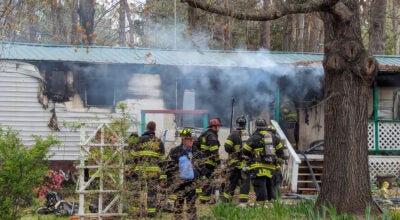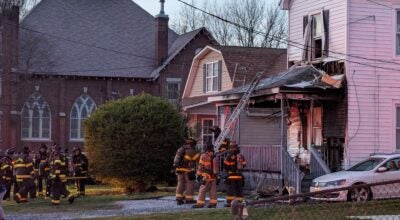Captains of industry, commerce made Salisbury mansion their home
Published 12:00 am Saturday, October 6, 2012
Here’s a capsule look at the history of the Hambley-Wallace House and the people behind it, taken from its National Register of Historic Places description and other sources.
SALISBURY – Egbert Barry Cornwall (E.B.C.) Hambley lived only a few years in the mansion he built at 508 S. Fulton St.
A British-born civil engineer educated at the Royal School of Mines in Kensington, London, Hambley came to Rowan County in 1881 to represent British investors in mining interests in Gold Hill.
After three years, he returned to England and worked for a leading engineering firm, John Taylor & England, which sent him to destinations such as India, Mexico, Africa, Norway and Spain.
Hambley returned to North Carolina and Rowan County in 1887, marrying Lottie Coleman. The couple would have five children.
Hambley built, owned and operated numerous granite and gold-mining sites and businesses in North Carolina, bringing millions of dollars into the local economy.
He organized the Salisbury Gas and Electric Light Co. and served on the boards of Salisbury Cotton Mills, the Davis and Wiley Bank and the Yadkin Railroad Co.
But Hambley may best be remembered for his early efforts to direct the building of the largest hydroelectric power plant in the Southeast at the Narrows point of the Yadkin River.
Hambley and others envisioned creating electrical power for the Piedmont region, banking on its generating tremendous wealth for industries and the people in it.
In 1899, Hambley organized the North Carolina Power Co. with capital stock of $5 million and bonds of $2.5 million. He also brought in as a principal investor George Whitney, a partner of Andrew Mellon’s in Pittsburgh.
Whitney bought controlling interest in Hambley’s company, formed the Whitney Development Co. and made Hambley general manager of his operations in North Carolina, which included Whitney Reduction Works.
Meanwhile, Hambley hired Charlotte architect Charles Christian Hook to design a house for him in Salisbury.
Historian Davyd Foard Hood said Hambley’s choice of the Chateauesque style “paid obvious reference to the recently completed Biltmore, as well as to the baronial styling of important seats erected in Great Britain in the last decade of the 19th century.”
Hood said that decade “reflected a certain penchant for French architecture.”
The Lazenby Brothers construction firm built the house between 1901 and 1903. Thomas Meehan & Sons of Philadelphia completed the layout of driveways, walks and the grounds around the house in 1904.
Tall granite standards, which once formed the perimeters of the original tennis court, still stand on the grounds.
Hood’s National Register nomination said this:
“Erected for a well-traveled, knowledgeable and discerning client, the Hambley-Wallace House was built of the finest materials available in the opening years of the century, outfitted with every domestic convenience of its time and constructed with sure, skilled craftsmanship by a local building company which demonstrated an unerring knowledge in its handling of granite, brick, slate, stained glass and both native and imported woods.”
The Raleigh News and Observer wrote a 1902 article on the house’s construction and noted, “this beautiful mansion is to be one of the handsomest residences in the South.”
The article spoke of the grand reception hall that would be 20-by-35 feet with a tiled floor and Austrian oak. It told of the eight bedrooms on the second floor alone and a third floor with more bedrooms and a large ballroom or billiard room that was 30-feet square.
“The house will have interior telephone service, hot water heating plant, complete electric equipment and every other convenience to make it a mode of perfection in residential architecture,” the newspaper said.
The Hambley-Wallace House was the most elaborate private residence designed by Hook and his partner, Frank McMurray Sawyer.
“It is certainly,” Hood said in his nomination, “the oldest and among the most impressive of a series of houses erected in the opening decades of the 20th century by North Carolina captains of business and industry.”
Hood placed it in company with the Z.V. Taylor/James Buchanan Duke House in Charlotte, Reynolda in Winston-Salem, the Abel Caleb Lineberger House in Belmont and Graylyn in Winston-Salem.
Hook, who died in 1938, also designed the 1917 Duke House and the 1921 Lineberger House. The Washington Building on North Main Street in Salisbury is a Hook-designed structure.
While Hambley successfully attracted Northern investors to the Whitney Dam project on the Yadkin, the mass undertaking failed. Its collapse in 1906 was sealed by a typhoid fever outbreak that wiped out many in Hambley’s workforce, plus Hambley himself.
He was 44 when he died in the house in 1906, only three years after its completion. Former U.S. Congressman John Steele Henderson and Salisbury Mayor Archibald Henderson Boyden were at Hambley’s death bed.
The dam would be completed 11 years later by the Aluminum Co. of America.
Hood wrote, “A town named Badin would represent a partial fulfillment of Hambley’s dream, and a tobacco tycoon, James Buchanan Duke, through the Southern Power Co. (today’s Duke Energy) would succeed on a scale Hambley anticipated but lacked the fortune and good luck to achieve.”
In 1917, Hambley’s widow, Lottie, sold the mansion to Salisbury banker John David Norwood and his wife, Mary Napolean McCanless Norwood.
But the Norwoods overextended themselves financially, leading to one of their creditors, Commercial National Bank of Washington, D.C., putting the house up for auction in 1923 on the Rowan County Courthouse steps.Interestingly, Mary Norwood was the high bidder at $38,000, so she retained ownership. But by 1927 she was in default with first her loan, then a mortgage,
Leo C. Wallace Sr. and his wife, Ella Belle, bought the home at auction in 1927 for $55,500 and furnished it lavishly.
Leo Sr. had started his career by joining his father, Victor, and brother Jacob in the family’s wholesale dry goods business – V. Wallace & Sons.
Victor Wallace died in 1918. His company became one of the largest dry goods concerns in the state with its own “Victor” brand.
His sons also opened a men’s clothing store, which operated into the 1920s.
The same year as Leo Sr. bought the house, he and his brother liquidated the wholesale business and focused entirely on managing and developing their extensive real estate holdings, which eventually would include Salisbury’s tallest building, the Wallace Building (today’s Plaza).
Jacob Wallace died and his funeral was held in the house in 1933. Leo Sr. died in 1935. His newspaper obituary described him as “Salisbury’s largest real estate owner and throughout his life one of the most influential and successful citizens.”
In 1941, Leo Jr. and Sudie Virginia Shaver married and moved into the house at his mother’s request. They would live in and maintain the home for 65 years.
Ella Belle Wallace, who also had a summer home in Myrtle Beach, died in 1958.
Leo and Virginia Wallace had three children: Lee, Suzanne and Victor. Leo Wallace Jr. worked tirelessly at building Wallace Realty, Belle Realty and the Holiday Inn – among other ventures – and played a prominent role in the business community, particularly in property development, industrial recruitment and residential construction.
His sons continue with the business today. Lee’s wife, Mona Lisa Wallace, became a prominent attorney and senior partner in Salisbury’s Wallace and Graham firm.
Lee and Mona Lisa Wallace bought the house from Lee’s siblings for $950,000 and a significant restoration began in March 2011.
Leo Wallace Jr. died in 2010; Virginia Wallace, in January of this year.




